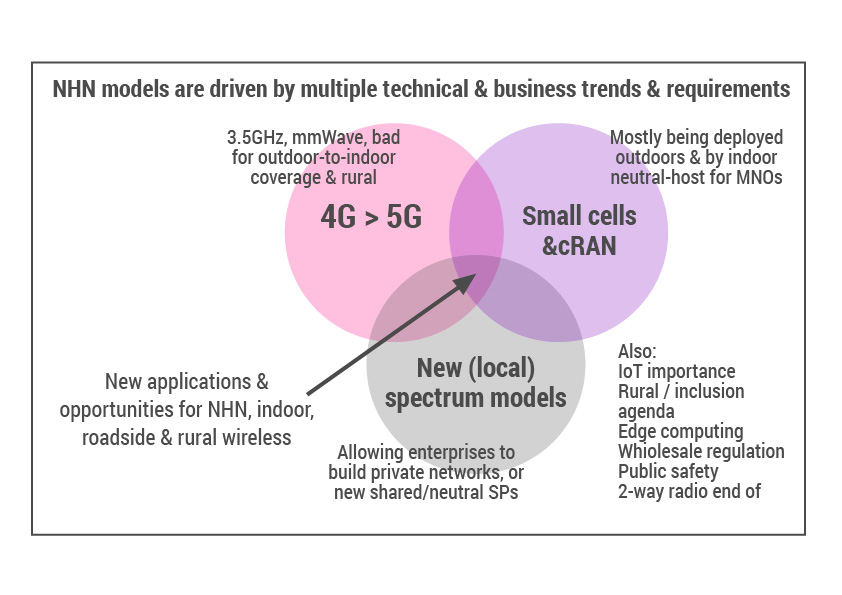Neutral Host Networks
The role of backhaul
One of the most interesting telecom industry trends is the reinvention of "wholesale" telecom, in its broadest definition. Wholesale models range from open-access fibre, through independent data-centres, to third-party mobile towers and many others. These allow physical or virtual assets to be shared by multiple service-providers, improving economic efficiency – and also, sometimes, accelerating time-to-market and reducing energy consumption.
Recently we have been witness to the emergence of a new, important class of mobile wholesaler - the mobile Neutral Host Network (NHN). An NHN is 3rd-party cellular network providing wholesale, commercial mobile coverage solutions – typically on a localised basis - to national mobile network operators (MNOs) or other communications service providers (CSPs).
There are various approaches to building and operating NHNs (see below), but all are basically RAN-as-a-Service providers, enabling improved cellular connectivity in places that are uneconomic – or too difficult to reach – for the MNOs to address directly. The idea is that an NHN builds a network (with or without its own local spectrum), and the other telcos either ‘roam onto it’ or used its shared facilities for their own radios.
While many of the key enablers and drivers of NHN are radio-related (such as small cells, and suitable local spectrum), the availability of suitable backhaul is also critical.
NHN use-cases
NHNs have many possible applications, with a common theme of extending 4G/5G networks in areas with poor coverage. While this mostly reflects difficult economics or tricky accessibility, an important secondary motivation is a desire by property owners or government authorities for more control of wireless - and ideally monetisation.
The most important use-cases for NHN deployment are:
- Rural / remote areas
- Urban centres needing 4G/5G RAN densification
- In-building / on-premise coverage for large sites such as shared office-space, entertainment venues and resorts
- Road and rail-side coverage
- Industrial sites and transport hubs
- Temporary sites and events, such as cultural events and major civil-engineering projects
Clearly, the backhaul and connectivity requirements of each of these domains varies widely – yet many will overlap with other trends. For instance, local authorities looking at the business case for smart-city infrastructure and fibre networks are starting to include NHN opportunities alongside connecting traffic/security control, or broadband for hospitals and universities
NHN deployment scenarios
There are several types of NHN models emerging, plus a number of other similar or overlapping approaches. The two most important versions of NHN are:
- Multi-Operator Small Cell as a Service (SCaaS), without the NHN having its own spectrum. This can either be utilized by multiple small cells with shared backhaul, or a single small cell virtualised and supporting multiple MNOs' frequency bands. This model is seeing particular traction in some cities, either extending a traditional TowerCo model, or where a new body has gained access to street furniture such as lighting-poles.
- Spectrum-based NHNs, where the provider is a full MNO in its own right, with its own local radio resources (shared or dedicated) and network, hosting other MNOs & SPs as tenants. In some markets, this is being explored for rural mobile deployment, and is also high on the agenda for some large property owners able to obtain spectrum. A major catalyst is the new CBRS shared-spectrum model seen in the US.
An additional model is for "pure" private 4G/5G networks, typically run by an enterprise for in internal IoT or voice applications, to also offer NHN capabilities as a secondary function. For instance, a 5G-enabled factory may have a primary focus on machine-vision and robots, but could also support employees’ & visitors' smartphone roaming onto the local network’s coverage.
This trend is not occurring in isolation. NHNs are evolving in parallel with a few other alternatives such as national roaming, network-sharing, or government-run/funded wholesale cellular networks.
Infrastructure and backhaul requirements for NHNs
NHNs typically use small cells, but not always. Clearly, for indoor use, the transport infrastructure will largely be dictated by some form of structured cabling. But some of the new localised-spectrum policies being proposed by regulators allow wholesale networks to cover much wider areas, especially those focused on rural deployments. As discussed before, that raises the question of whether the transport infrastructure has sufficient reach, and the right price-points and capabilities. It is possible that NHN models themselves become an extra driver of the economics of rural broadband rollout – and it is important that any government policies or incentive funding recognise this.
In the important domain of urban metro-densification, it is expected that the levels of bandwidth needed for 5G or advanced 4G will require fibre to the radios, whether that is a “full”, small, self-contained cell, or a remote radio unit for a cloud-based RAN. In some cases, it may be possible to use high-capacity microwave or mmWave for backhaul, but Disruptive Analysis expects fibre to predominate in most cases, at least to “hub” locations.
For road- and rail-side coverage, it is likely that the relevant authorities - or the telcos they assign as contractors/licensees - will want to create multi-purpose fibre transport infrastructure. They will have their own internal connectivity requirements, in addition to looking at both individual MNOs and shared network (including NHNs) as tenants on the networks.
In some countries there is a major push for advanced networks along transport routes – and some may even specify 5G. Where this uses high frequency bands, it is unlikely that all the national operators will be able to build out coverage independently, and thus some form of network-sharing will be essential. Various trials and concepts are pointing to NHN as a suitable approach, albeit not the only one.
Summary
Neutral Host Networks are expected to be an important part of the future 4G and 5G landscape, in various contexts. The uncertainties of 5G timelines (and traditional telcos’ worsening economics) is driving governments and regulators to support new wholesale models of cellular infrastructure build-out.
New approaches to releasing spectrum, coupled with easier regulation with regards to siting radios, are enablers. But the NHN model cannot function without adequate backhaul and transport, and so this area is likely to see continued focus from fixed infrastructure owners.
Dean Bubley and Disruptive Analysis have extensively researched the marketplace for NHNs, examining catalysts and obstacles, and what opportunities that provides for adjacent SPs and other companies. If this area is of potential relevance, please contact disruptive-analysis.com for details.





